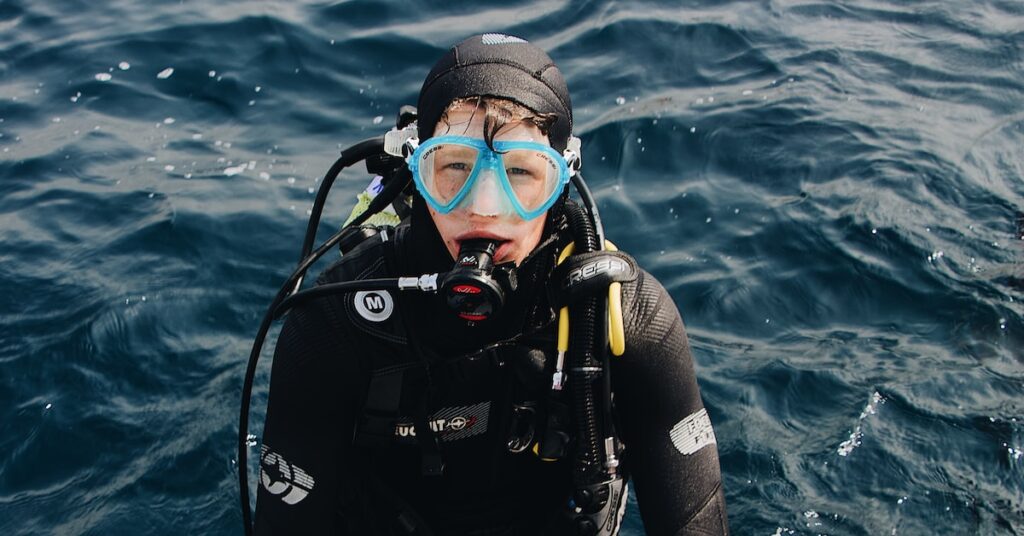

Scuba divers do not float due to the diving weights they carry and the assistance of a buoyancy control device (BCD). These, along with certain techniques a diver can learn, help reach certain levels of buoyancy to allow the diver to reach their desired position in the water.
Keep reading as we explain how buoyancy affects diving, the tools divers use to sink or float, and how they use them.
Looking at Buoyancy
Buoyancy is the upward force that acts opposite of the weight of an object immersed in liquid.
There are three terms we will use in this article:
- Positive buoyancy refers to buoyancy inclined to float (like a ping pong ball in water).
- Negative buoyancy is that which is inclined to sink (like a lead ball in water).
- Neutral buoyant objects hold their position in the liquid.
When we talk about floating, sinking, and controlling depth, it all relates back to buoyancy.
How Do Scuba Divers Stay Underwater Without Floating Up?
When actively scuba diving, divers want to achieve a state of either neutral buoyancy or negative buoyancy. While a buoyancy control device works well to help you reach a certain position, dive weights are best acknowledged for keeping you underwater.
Our bodies are naturally positively buoyant. The air you fill your lungs with increases your chances of floating, as does any percentage of fat on your body. On top of this, some of your gear (such as your wetsuit) also has positive buoyancy.
Dive weights help counter this positive buoyancy by adding weight without any contribution to floating tendencies. Your BCD will help you counter this to get where you want to be, but the dive weights help you stay underwater without inclination to float up.
Why Do Scuba Tanks Not Float?
Scuba tanks are usually negatively buoyant, especially when they are filled with air. When a scuba tank is full, it can weigh over 40lbs. While weight doesn’t directly relate to buoyancy, most objects are more likely to sink the more that they weigh.
According to Archimedes Principle, the upward force an item experiences is equal to the liquid that the item has displaced. Full tanks are more likely to displace a larger volume of liquid, and they are less likely to float in the water.
Steel Tanks vs. Aluminum Tanks
Steel tanks are almost always negatively buoyant, even when they are empty.
Aluminum tanks, which usually weigh more, actually tend toward positive buoyancy when they are empty. As they lose the weight of the compressed air throughout the dive, they start to float, and divers must learn to offset this buoyancy for their dive.
Is Buoyancy All That Matters With Tank Choice?
You might think that choosing the negatively buoyant steel tank is always your best choice, but there are other factors to consider.
Aluminum tanks are actually preferred by most divers, including diving schools and professionals. They are cheaper and easier to use, and they work well for:
- Shallow dives
- In saltwater
- For smaller divers
Steel tanks cost more due to their material, but they’re more difficult to take care of (especially if you frequent salt water diving). Divers prefer them for their:
- Higher air capacity
- Durability
- Assistance for longer, deeper dives
While you should consider the buoyancy of a scuba tank, it shouldn’t be the determining factor in your choice.
How Do Divers Not Sink?
A diver’s first line of defense against sinking is their natural positive buoyancy. Anyone with air in their lungs is more inclined to float than sink, and it works well to prevent us from accidentally drowning.
If you’ve ever just laid back in a pool and floated at the surface, you understand. Your body fat is also positively buoyant, and even thin individuals have some percentage body fat to keep them afloat. Muscle, on the other hand, is more likely to sink in the water.
Beyond this, divers use a BCD to control their position in the water. The BCD has a bladder that can be filled with air to make a diver more positively buoyant and prevent them from sinking.
How Do Scuba Divers Sink and Float?
A diver’s BCD can be inflated or deflated to allow them to sink or float.
These come in multiple styles, including those that wrap around like jackets or simpler wing harnesses that have just the bladder and the straps.
The bladder connects to a hose called a low-pressure inflator (LPI) that attaches to the tank. There are two buttons to inflate or deflate the bladder, controlling how much air goes in or is released.
When you press ‘inflate’ it adds air to the bladder, leaning to positive buoyancy that allows the diver to float. Deflating the bladder removes air, and the diver becomes more negatively buoyant and should start to sink.
You cannot over inflate the bladder; it will release air when full, and you can usually hear this over your shoulder.
References
https://www.downtoscuba.com/how-do-scuba-divers-go-up-and-down/
https://www.downtoscuba.com/why-do-we-need-weights-in-scuba-diving/
